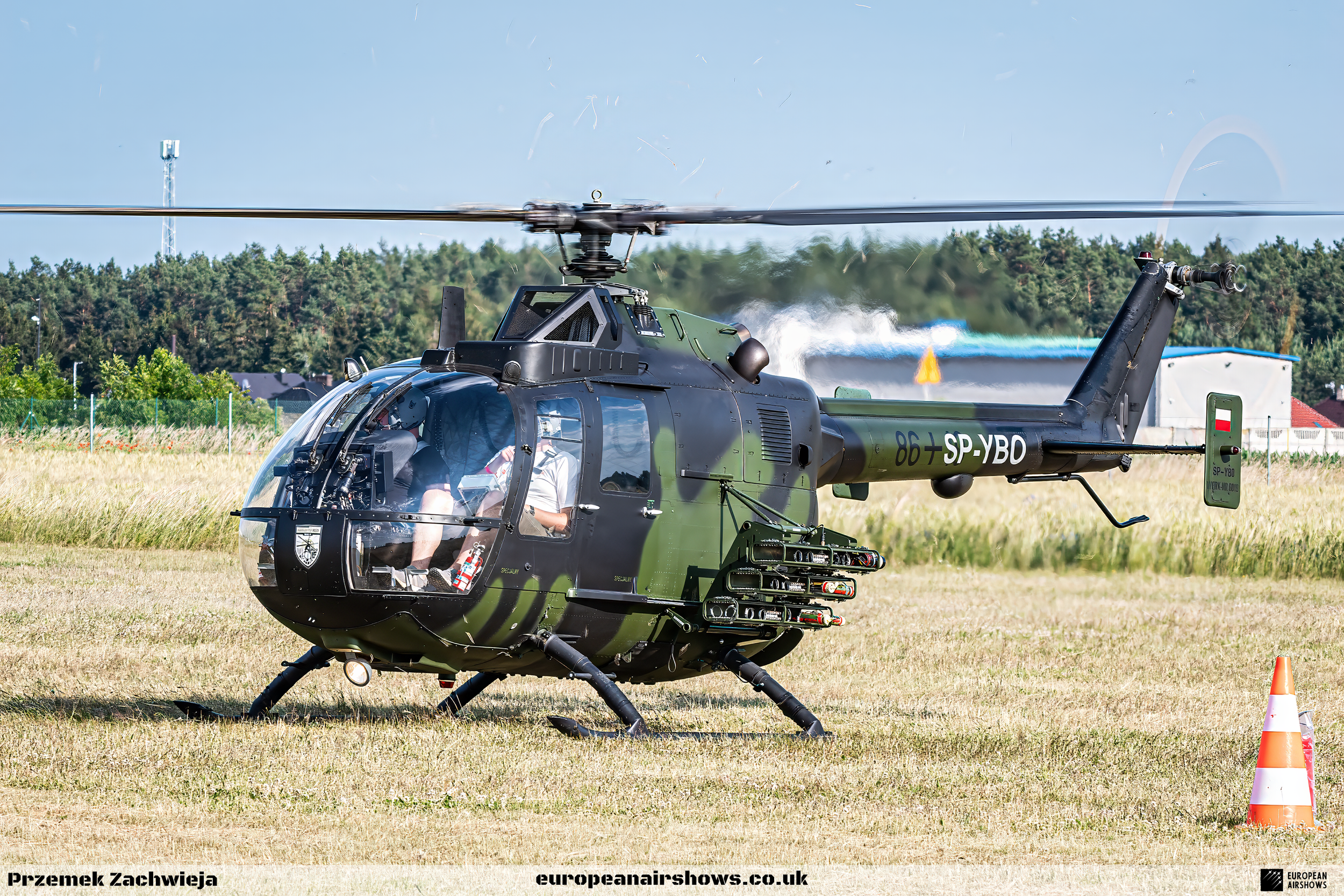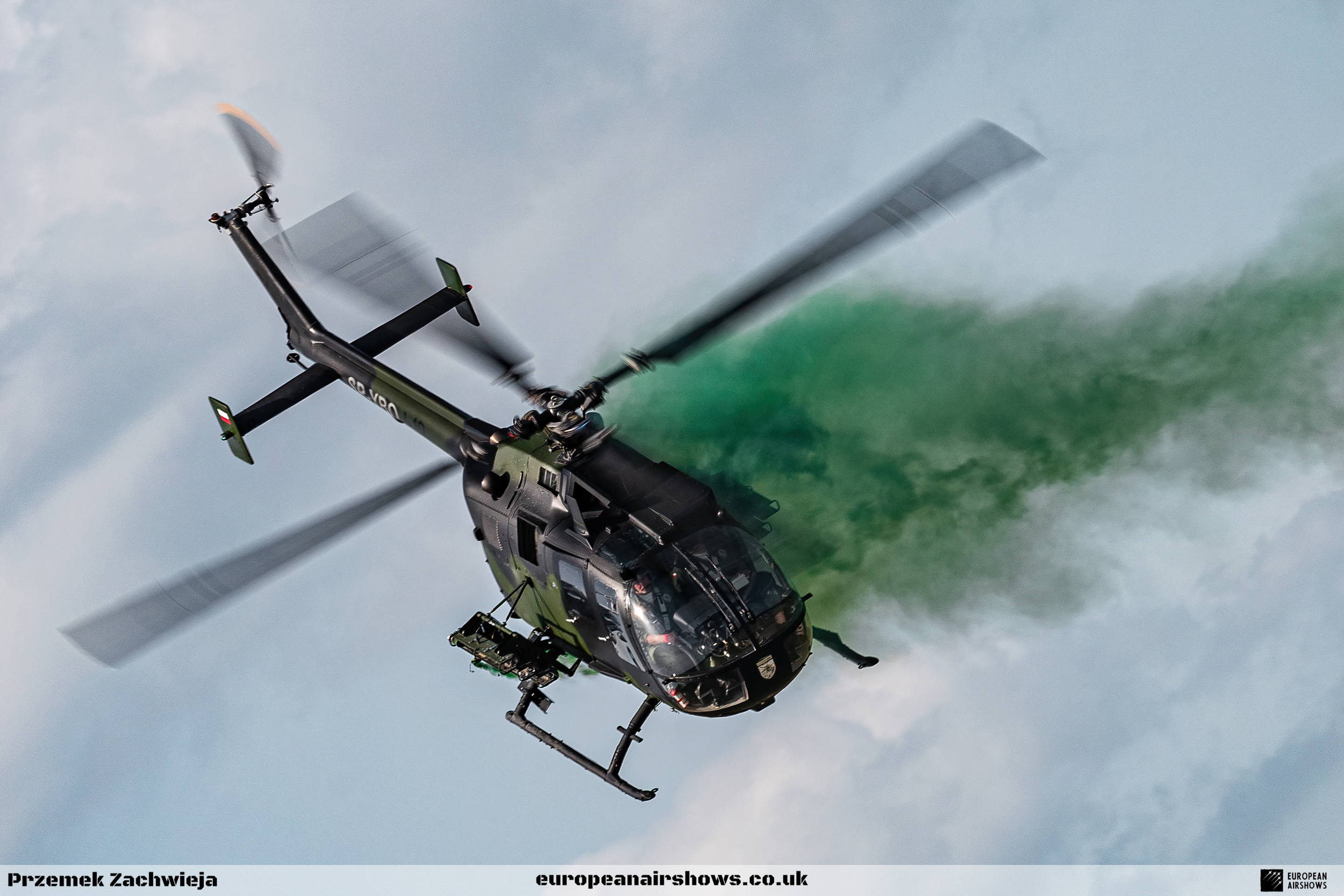
February 16 / MBB Bo 105 first flight
First Flight 16 February 1967
MBB Bo 105
The Messerschmitt-Bölkow-Blohm Bo 105 stands as a landmark in civil and military rotorcraft development, being the world’s first light twin-engine helicopter and the first rotorcraft capable of performing aerobatic maneuvers such as inverted loops. Its journey began in the mid‑1960s when Bölkow initiated work on a revolutionary hingeless rotor system—a design breakthrough that would later become synonymous with the Bo 105’s agile and responsive performance. Early research and development efforts laid the groundwork for what would eventually become a helicopter that not only pushed the boundaries of engineering but also captured the imagination of pilots and aviation enthusiasts around the globe.
Development formally kicked off in 1964 with the inception of the helicopter’s new airframe, rotor system, and engine configuration. On 16 February 1967, the second prototype of the Bo 105A made its maiden flight at Ottobrunn, West Germany, and by May of that same year it had already been showcased to the public. In order to fast-track the testing phase, the initial prototypes utilized existing rotor blades from Westland Helicopter’s Scout rotorcraft and Allison Model 250 turboshaft engines as stand-ins for the final production components. This judicious mix of innovation and adaptation allowed the development team to iterate rapidly, ensuring that when the German Civil Aviation Authority certified the Bo 105 on 13 October 1970, the aircraft was ready to meet both civilian and military demands.
Following certification, deliveries commenced rapidly, with early operators including ADAC Air Rescue and the Bavarian State Police setting the stage for what would become a global success story. In 1972, after securing further certifications from the U.S. Federal Aviation Administration and Britain’s Civil Aviation Authority, the helicopter’s popularity soared with export orders flowing in from across the Atlantic and beyond. That same year, the Bo 105C was introduced—a more powerful variant that quickly superseded its predecessor by offering enhanced performance thanks to improved Allison 250-C20 turbine engines. The experimental Bo 106, with its widened cabin designed to seat more passengers comfortably, also made its debut around this time, although it remained an intriguing one-off rather than a main production model.
Continuing evolution was a hallmark of the Bo 105’s continual development. The introduction of the Bo 105CB in 1976, powered by more robust Allison 250-C20B engines, modernized the design further and opened avenues for specialized adaptations. Recognizing the growing demand in emergency medical services in the United States, the Bo 105CBS variant was developed with a modest fuselage stretch, earning it the nickname “Twin Jet” for its improved internal space and performance. Industry collaboration played a significant role during these years, with U.S. aerospace giant Boeing-Vertol acting as both a partner in production and a key marketer of the Bo 105 in the American market. As the helicopter’s appeal spread across continents, license manufacturing agreements enabled production to expand beyond Germany into countries such as Canada, Spain, Indonesia, and the Philippines.
The design of the Bo 105 was as innovative as it was practical. Its hingeless rotor system, anchored by a solid titanium rotor head and reinforced with glass-fiber composite blades, delivered unrivaled stability and responsiveness. This rigid rotor arrangement not only set a new standard for aerobatic performance—enabling steep dives, loops, rolls, and even turnover maneuvers—but also simplified maintenance and extended the operational lifespan of its rotor blades. Coupled with its twin-engine configuration, the helicopter’s light weight permitted impressive takeoff and climb capabilities, making it an invaluable asset for a wide array of roles, from emergency medical transport to military reconnaissance.
As the decades passed, further refinements continued to bolster the Bo 105’s reputation. The development of the Bo 105LS and its subsequent variants during the 1980s and early 1990s addressed the evolving requirements of high altitude and hot weather operations, as well as increased maximum take-off weights to meet specialized mission profiles. Collaborations with Eurocopter Canada and other international partners spurred these advances, ensuring that the helicopter remained competitive even as newer models entered the market. By the time production formally concluded in 2001, Eurocopter (now Airbus Helicopters) had produced more than 1,400 units in Germany alone, with total production—including license-built aircraft from around the world—approaching 1,640 rotorcraft delivered to operators in 55 nations.
Even after production ceased, the legacy of the Bo 105 continued in the form of further upgrades and conversions aimed at meeting the changing demands of military and civilian operators. Numerous variants emerged over its production life, each tailored for specific tasks such as anti-tank warfare, maritime reconnaissance, search and rescue, and air ambulance services. These custom configurations underscored the helicopter’s versatility and its enduring appeal in diverse operational theaters, from low-level military missions to high-end emergency medical responses.
Bo 105 Facts
First Twin-Engine Pioneer: The Bo 105 was the world’s first light, twin-engine helicopter, setting the stage for multi-engine rotorcraft designs worldwide.
Aerobatic Trailblazer: It was the first rotorcraft capable of performing aerobatic maneuvers such as inverted loops, showcasing its advanced design and versatility.
Revolutionary Rotor System: Featuring a hingeless (or rigid) rotor system when introduced in 1970, the Bo 105’s design allowed greater control and simpler maintenance by eliminating traditional rotor hinges.
Composite Blade Innovation: Its rotor blades are constructed from reinforced-plastic glass-fiber composite material, enhancing durability and reducing maintenance challenges, a pioneering approach in rotorcraft engineering.
Agile and Responsive Handling: Thanks to its advanced rotor system and design, the Bo 105 can perform steep dives, rolls, loops, and turnovers—making it popular both in tactical operations and aerobatic displays by pilots like Aaron Fitzgerald for Red Bull.
Low-Altitude Excellence: Its excellent flight qualities enable safe and effective operation at low altitudes, which is particularly valuable for military missions where minimizing visibility is crucial.
Global Production Footprint: While most units were manufactured in Germany (around 1,400), additional production lines in Canada, Spain, Indonesia, and the Philippines brought the total production to about 1,640 units.
Safety Record Superstar: The advanced rotor system of the Bo 105 has an outstanding safety record—accumulating over six million operating hours with zero rotor system failures reported as of 1991.
Versatile Mission Adaptability: The helicopter’s design allowed it to be configured for numerous roles including emergency medical services (EMS), maritime operations, armed reconnaissance, and anti-tank missions, thanks to various customized variants.
Legacy and Evolution: The Bo 105’s innovative design paved the way for later models, and although it was eventually succeeded by the Eurocopter EC135, its influence endures as a foundational element in modern light helicopter technology.


















